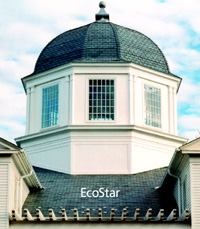The craftsmanship required to work with delicate, costly materials and achieve a beautiful, classic roof gives slate and shakes lasting cachet in the custom home market. But with today’s increasing focus on green building as well as on low-maintenance homes, interest is growing in alternative roofing products—especially those that can realistically capture the texture, color variation, and rooftop appearance of natural materials while delivering better performance.
The small but growing category of synthetic roofing products offers an alternative to custom builders who prefer not to use resources that are not rapidly renewable—or that are not renewable at all—but want to incorporate the look of slate or shakes into clients’ homes. Even for those who are more interested in durability and longevity than in environmental friendliness, synthetic roofs can be a good choice.
Many synthetic products convincingly replicate the look of cedar shakes or slate shingles and also deliver key performance benefits. Advanced materials and manufacturing technologies give the products better resistance to weathering, greater durability, and longer lifespans than real slate or cedar, according to manufacturers. “You emulate the natural material, but get performance and longer life over the natural product,” says Charlotte, N.C.-based custom builder Jay Robinette, who has used Enviroshakes. “You’re saving on potential callbacks.”
Synthetic slate and shake products are manufactured from a variety of different materials, primarily polymers and/or rubber along with fillers and modifiers. Although the products seem similar, formulations vary among manufacturers.
“There are so many plastic or rubber compounds that can be utilized that to say they’re all the same couldn’t be further from the truth,” points out Brian Eberle, vice president of marketing and sales for Wellington Polymer Technologies.
The polymeric composition of most synthetic shingles and shakes generally includes advanced UV inhibitors and impact modifiers. Some products incorporate ingredients such as recycled rubber or plastic, mineral dust, or cellulose fibers, while others use virgin rubber and plastic.
The majority of synthetic slates and shakes are backed by 50-year warranties. Most are UL-certified for Class 4 impact resistance, and many, but not all, also achieve Class A fire resistance. Some are also rated to resist uplift in high winds.
Compared with natural shakes and slate, synthetic roofing products offer easier installation and generate less waste on the jobsite. They come in several sizes to minimize the need for cutting, and because the products are of consistent quality, each piece is usable.
Synthetic slate in particular is easier to work with than natural slate; it is lighter in weight and does not require a reinforced roof. Plus, breakage during shipping or installation is virtually nonexistent, manufacturers say.
Both synthetic slate and shake can be cut using standard wood- or stone-cutting saws. In most products, the surface color goes all the way through the piece, so when cuts are made the appearance does not change and there is little need to hide cut edges. They can also be installed using pneumatic nailers, unlike real slate and cedar shakes.
Shades of Green. The question of whether synthetic roofing products have green characteristics must be answered on a product-by-product basis. They are all polymer-based, which means they are made from a petroleum-derived material. Some synthetic slates and shakes are manufactured using recycled content and some are not. Those that use recycled content typically use post-industrial materials from automotive and other industries, but a few incorporate a small amount of post-consumer content such as recycled tire rubber.
A long life expectancy—supported by extensive industry testing for UV resistance, low water absorption, and resistance to freeze/thaw cycles—means that roofs don’t have to be replaced every 15 to 30 years, and the products’ resilience means that fewer repairs will have to be made during the roof’s lifetime.
Even the products that do not use recycled content can, in the end, be considered somewhat “green.” Because they are polymer-based, the majority of synthetic slates and shakes can be recycled at the end of a roof’s lifespan.
It may be difficult to sell some clients on the idea of a polymer-based roof unless you have firsthand experience of the product. Architect Wayne Visbeen of Grand Rapids, Mich., has used a synthetic slate on only two projects, one of which is his own home. “I wanted to use this particular roof on several projects this year, but it’s very hard to recommend that another client use an unproven product,” he says, “so I put it on my house.”
Self-educating consumers looking for cutting-edge products are one of the biggest driving forces behind the slow but steady growth of the synthetic roofing category. “It seems that the credibility of this category is beginning to find a place, and people are becoming more and more secure with polymer-based shingles designed by chemists and engineers,” says John Humphries, president of DaVinci Roofscapes.
Tamko Roofing Products



